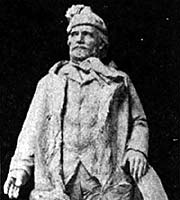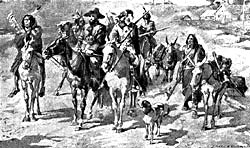Marcus and Narcissa Whitman
 |
| American pioneer and Protestant missionary Marcus Whitman is memorialized in this statue. Whitman led the first great migration to the Oregon country. Image © 2002 clipart.com. |
The journey of Marcus and Narcissa Whitman weaves the opening of the West to American settlers and the growing resentment native tribes felt as they began to be pushed from lands they lived in for generations.
The Whitmans were missionaries from upstate New York. Marcus, born in 1802, had received a medical degree and doctored in Canada for four years before returning to New York and becoming an elder of the Presbyterian Church. His wife was born Narcissa Prentiss in 1808 into a devout Presbyterian family. She was a very religious child and at age 16 pledged her life to missionary work. In 1835 Marcus visited Oregon to scout potential mission sites. Before Marcus' trip Narcissa volunteered as a missionary to the American Board of Commissioners for Foreign Missions, the umbrella group for Protestant missions to Indian peoples. The board refused to send unmarried women as missionaries. Marcus eventually spent a weekend with the Prentiss family, and the couple agreed to be married so they could become missionaries together.
In 1836 the Whitmans joined Henry Spalding and his wife, Eliza, and another missionary, William H. Gray, to return to Oregon. They traveled with fur traders mainly. Narcissa and Eliza became the first white women to cross the Rockies.
The Whitmans reached the Walla Walla River Sept. 1, 1836, and soon started a mission among the Cayuse Indians at Waiilatpu. The Spaldings continued to Idaho and started a mission there among the Nez Perce.
Despite the Whitman's efforts—Marcus held church service, practiced medicine, and constructed buildings; Narcissa taught in the mission school—the Cayuse weren't swayed. They soon considered the Whitmans a threat. After all, the Whitmans made little effort to preach in the native Cayuse tongue or to relate their message in terms of Cayuse beliefs. For instance, Cayuse social and political life emphasized gift giving; the Whitmans thought that was extortion.
 |
| Marcus Whitman starts back for the East, from an engraving by Oliver W. Nixon. Whitman’s missionary work with the Cayuse Indians came to a tragic end in 1847. Image © 2002 clipart.com. |
By 1842 the American Missionary Board recalled the Whitmans because of their lack of success converting the Cayuse. Marcus headed back east and successfully convinced the board to let them continue. On his return trip in 1843 he helped lead the first great migration to the West. A wagon train of 1,000 pioneers followed him up the Oregon Trail.
The coming of more white settlers created more distrust among the Cayuse. The Whitmans, who had lost their two-year-old daughter in a drowning in 1839, were spending most of their time helping fellow whites. They had taken in 11 children of deceased immigrants and adopted 7 of them.
With the onrush of new settlers came numerous diseases, which ravaged the Cayuse. That situation created more distrust by the Cayuse of the Whitmans, who doctored the arriving wagon trains. The problem came to a head in 1847. A measles epidemic killed half of the Cayuse and nearly all their children. Meanwhile, most of the white children lived. The Whitmans cared for both.
On Nov. 29 Chief Tiloukaikt led his Cayuse in a massacre of 14 whites, including the Whitmans, as revenge for what they saw as the Whitmans' treachery. Indian tradition held medicine men personally responsible for the patient's recovery, and the Cayuse thought Whitman was causing the Indians' deaths. The Cayuse burned the mission buildings as well.
A white militia attack on a band of uninvolved Cayuse escalated the conflict into war. The ravaged Cayuse stood little chance. Two years later Tiloukaikt and four others involved in the massacre voluntarily surrendered to avoid the destruction of the entire tribe. They were put to death but remained defiant to the end.
Where the Whitmans and numerous other Protestant missions failed, many Catholic missionaries prospered. First, the Catholics did not insist on the Indians' changing their lives as a condition for baptism. The mystery of the Catholic Mass, with its priests in vestments burning incense, ringing handbells, and reciting rituals, also brought more interest to the Indians, themselves a ritualistic people. The Catholics also more easily gained the Indians' trust. The Catholic priests were single, having taken a vow of chastity, and were bound by a commitment to poverty. They weren't interested in staking land claims. Plus, they already had connections to many Indians because Indian women from almost every tribe in the Pacific Northwest had married Catholic men. And unlike the Whitmans, the priests were skilled linguists who were willing to undergo years of patient work to learn the native languages.
Still, the Protestant missionaries had an impact in other ways. They showed that families from the east could thrive in the Oregon Country. They opened up the land to farming. They sent word back East to the potential of this region, with its mild climate, fertile soil, and abundant timber, fish, and game. They helped set the stage for the opening of the Oregon Trail.
< back | next > | 


